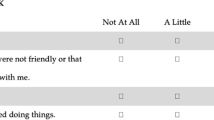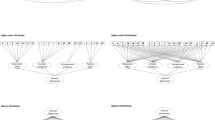Abstract
The self-report questionnaire Center for Epidemiological Studies - Depression Child (CESDC) was used for screening depression in Swedish 16–17 year olds during their first year in high school. Completed questionnaires were produced by 2272 students (92% of the population). The mean score was 13.2 (boys 9.9; girls 16.5). Factor analysis gave the same factors for boys and girls with a strong main factor for depressed mood. High scores of 30 or above were found in 240 cases (10.3%). Of those, 204 (85%) and the same number of controls with low scores were interviewed with the Diagnostic Interview for Children and Adolescents (DICA-R-A). Depressive diagnosis during the last year was confirmed in 71% of high scorers and 15% of low scorers. Beck's depression inventory with cut off at score 16 was used in the same material with equal result. Used with high cut off scores the CES-DC was specific enough for discovering depressive disorder.
Similar content being viewed by others
References
Albert N, Beck AT (1975) Incidence of depression in early adolescence: A preliminary study. Journal of Youth and Adolescence 4:301–307
Ambrosini PJ, Metz C, Bianchi MD, Rabinovich H, Undie A (1991) Concurrent validity and psychometric properties of the Beck Depression Inventory in outpatient adolescents. Journal of the American Academy of Child & Adolescent Psychiatry 30:51–57
Angold A, Worthman CW (1993) Puberty onset of gender differences in rates of depression: A developmental epidemiologic and neuroedocrine perspective. Journal of Affective Disorder 29:145–158
Beck AT, Ward CH, Mendelson M, Mock J, Erbaugh J (1961) An inventory for measuring depression. Archives of General Psychiatry 45:561–571
Boyd JH, Weissman MM, Thompson WD, Myers JK (1982) Screening for Depression in a community sample. Archives of General Psychiatry 39:1195–1200
Craig GW van Natta PA (1976) Presence and persistence of depressive symptoms in patient and community populations. American Journal of Psychiatry 36:149–154
Craig GW van Natta PA (1978) Current medication use and symptoms of depression in a general population. American Journal of Psychiatry 135:1036–1039
Craig GW, van Natta PA (1979) Influence of demographic characteristics on two measures of depressive symptoms. Archives of General Psychiatry 35:149–154
Cohen P, Cohen J, Kasen S, Velez CN, Hartmark C, Johnson J, Rojas M, Brook J, Streeuning EL (1993) An epidemiological study of disorders in late childhood and adolescence. I. Age and gender specific prevalence. Journal of Child Psychology & Psychiatry 34:851–867
Doerfler LA, Felner RD, Rowlison RT, Raley PA, Evans E (1988) Depression in children and adolescents: A compara tive analysis of the utility and construct validity of two assessment measures. Journal of Consultant and Clinical Psychology 56:769–772
Faulstich ME, Carey MP, Ruggiero L, Enyart P, Gresham F (1986) Assessment of depression in childhood and adoles cence: An evaluation of the Center for Epidemiological Studies Depression Scale for Children (CES-DC). American Journal of Psychiatry 143:1024–1027
Fendrich M, Weissman MM, Warner V (1990) Screening for depressive disorder in children and adolescents: Validating the Center for Epidemiologic Studies Depression Scale for Children. American Journal of Epidemiology 131:538–551
13.Fergusson DM, Horwood LJ, Lynskey MT (1993) Prevalence and comorbidity of DSM-III-R diagnosis in a birth cohort of 15 year olds. Journal of the American Academy of Child & Adolescent Psychiatry 32:1127–1134
Garrison CZ, Schluchter MD, Schoenbach VJ, Kaplan BK (1989) Epidemiology of depressive symptoms in young adolescents. Journal of the American Academy of Child & Adolescent Psychiatry 28:343–3511
Garrison CZ, Jackson KL, Marsteller F, McKeown R, Addy C (1990) A longitudinal study of depressive symptomatol ogy in young adolescents. Journal of the American Academy of Child & Adolescent Psychiatry 29:581–585
Garrison CZ, Addy L, Jackson KL, McKeon KL, Wallet JL (1991) The CES-D as a screen for depression and other psychiatric disorders in adolescents. Journal of the American Academy of Child & Adolescent Psychiatry 30:636–641
Garrison CZ, Jackson KL, McKeown RE, Waller JL (1992) Major depressive disorder and dysthymia in young adoles cents. American Journal of Epidemiology 135:792–802
Hammen LH, Padesky AC (1977) Sex differences in the expression of depressive responses on the Beck Depression Inventory. Journal of Abnormal Psychology 86:609–614
Herjanic B, Reich W (1982) Development of a structured psychiatric interview for children: Agreement between child and parent on individual symptoms. Journal of Abnormal Child Psychology 10:307–324
Kaplan SL, Hong GK, Weinhold C (1984) Epidemiology of depressive symptomatology in adolescents. Journal of the American Academy of Child Psychiatry 23:91–98
Kashani JH, Sherman DD, Parker DR, Reid JC (1990) Utility of the Beck Depression Inventory with clinic-referred adolescents. Journal of the American Academy of Child & Adolescent Psychiatry 29:278–282
Larsson B, Melin L (1990) Depressive symptoms in Swedish adolescents. Journal of Abnormal Child Psychology 18 91–103
23.Lewinsohn PM, Hops H, Roberts RE, Seeley JR, Andrews JA (1993) Adolescent psychopathology: I. Prevalence and incidence of depression and other DSMIII-R disorders in high school students. Journal of Abnormal Psychology 102:133–144
Myers JK, Weissman MM (1980) Use of a self-report symptom scale to detect depression in a community sample. American Journal of Psychiatry 137:1081–1084
Olsson G, von Knorring A-L (1997) Beck's depression inventory as a screening instrument for adolescent depres sion: Gender differences. Acta Psychiatrica Scandinavica 95:277–282
Radloff LS (1977) The CES-D Scale: A self-report depression scale for research in the general population. Applied Psychological Measurement 1:385–401
Roberts RE, Lewinsohn PM, Seeley JR (1991) Screening for adolescent depression: A comparison of depression scales. Journal of the American Academy of Child & Adolescent Psychiatry 30:58–66
Shoenbach VJ, Kaplan BH, Grimson RC, Wagner EH (1982) Use of a symptom scale to study the prevalence of de pressive syndrome in young adolescents. American Journal of Epidemiology 116:791–800
Teri L (1982) The use of Beck's depression inventory with adolescents. Journal of Abnormal Child Psychology 2:277–284
Wells VE, Klerman GL, Deykin EY (1987) The prevalence of depressive symptoms in college students. Social Psychiatry 22:20–28
Welner Z, Reich W Herjanic B, Jung KG, Amado H (1987) Reliability, validity and parent-child agreement studies of the diagnostic interview for children and adolescents (DICA). Journal of the American Academy of Child & Adolescent Psychiatry 26:649–653
Weissman MM, Sholomskas D, Pottenger M, Prusoff BA, Locke BZ (1977) Assessing depressive symptoms in five psychiatric populations: A validation study. American Journal of Epidemiology 106:203–214
Weissman MM, Klerman GL (1977) Sex differences in the epidemiology of depression. Archives of General Psychiatry 34:98–111
Author information
Authors and Affiliations
Rights and permissions
About this article
Cite this article
Olsson, G., von Knotting, A.L. Depression among Swedish adolescents measured by the self rating scale Center for Epidemiology Studies - Depression Child (CES-DC). European Child & Adolescent Psychiatry 6, 81–87 (1997). https://doi.org/10.1007/BF00566670
Received:
Accepted:
Issue Date:
DOI: https://doi.org/10.1007/BF00566670




